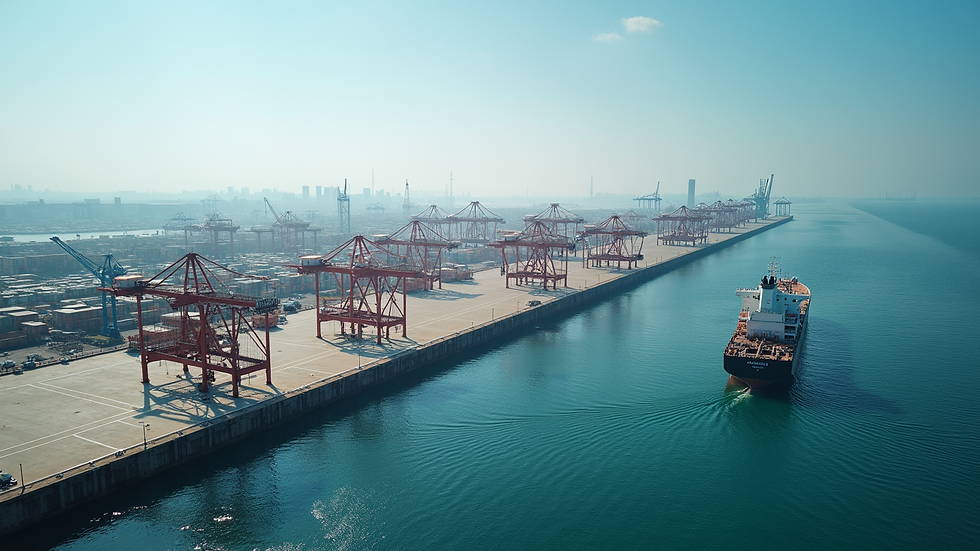Innovative Approaches to Greener Oceans and Maritime Growth
- Elizaa Liza
- Aug 18
- 3 min read
The oceans are vital to our planet's health and economy. They provide food, transportation routes, and recreational opportunities. However, maritime activities have also contributed to pollution, habitat destruction, and climate change. To protect these waters while supporting economic growth, innovative approaches are essential. This article explores practical solutions and emerging trends that promote greener oceans and sustainable maritime growth.
Embracing Technology for Greener Oceans
Technology plays a crucial role in reducing the environmental impact of maritime operations. New innovations help monitor ocean health, reduce emissions, and improve energy efficiency.
Emission Reduction Technologies: Ships are adopting cleaner fuels such as liquefied natural gas (LNG) and biofuels. Additionally, scrubbers and selective catalytic reduction systems help reduce sulfur oxides and nitrogen oxides emissions.
Energy Efficiency: Advanced hull designs and air lubrication systems reduce drag, lowering fuel consumption. Hybrid propulsion systems combining diesel engines with electric motors also contribute to greener operations.
Digital Monitoring: Satellite and drone technologies provide real-time data on ocean conditions, pollution levels, and marine traffic. This information helps optimize routes and avoid sensitive ecosystems.
These technologies not only reduce the carbon footprint but also enhance operational efficiency, benefiting both the environment and the maritime industry.

Strategies for Greener Oceans in Maritime Operations
To achieve greener oceans, maritime stakeholders must adopt comprehensive strategies that balance growth with environmental stewardship.
Port Innovations: Ports are implementing shore power systems that allow docked ships to turn off their engines and plug into the local electric grid. This reduces air pollution in port cities.
Waste Management: Strict regulations and onboard waste treatment systems prevent the discharge of plastics and other pollutants into the ocean.
Marine Protected Areas (MPAs): Establishing MPAs restricts harmful activities in critical habitats, allowing ecosystems to recover and thrive.
Collaboration and Policy: International cooperation through organizations like the International Maritime Organization (IMO) ensures consistent environmental standards and enforcement.
By integrating these strategies, the maritime sector can significantly reduce its environmental impact while supporting economic development.

What is maritime sustainability?
Maritime sustainability refers to the responsible use and management of ocean resources to meet current needs without compromising the ability of future generations to benefit from them. It involves balancing economic growth, environmental protection, and social equity in maritime activities.
Key components include:
Environmental Protection: Minimizing pollution, conserving biodiversity, and reducing greenhouse gas emissions.
Economic Viability: Ensuring maritime industries remain profitable and competitive while adopting sustainable practices.
Social Responsibility: Supporting the well-being of coastal communities and workers in the maritime sector.
Sustainable maritime development requires innovation, regulation, and cooperation among governments, businesses, and communities. For example, cruise lines are increasingly adopting eco-friendly technologies and practices to reduce their environmental footprint while enhancing passenger experiences.

Innovative Solutions Driving Sustainable Maritime Development
The concept of sustainable maritime development is gaining momentum as the industry seeks to harmonize growth with environmental care. Some innovative solutions include:
Green Ship Design: Incorporating renewable energy sources like solar panels and wind turbines on vessels to supplement power needs.
Alternative Fuels: Research into hydrogen fuel cells and ammonia as zero-emission alternatives is progressing rapidly.
Smart Shipping: Using AI and big data analytics to optimize routes, reduce fuel consumption, and predict maintenance needs.
Circular Economy Practices: Recycling ship materials and repurposing waste products to minimize resource use.
Community Engagement: Involving local populations in conservation efforts and decision-making processes to ensure sustainable outcomes.
These approaches not only reduce environmental harm but also create new business opportunities and enhance the reputation of maritime companies.
Navigating the Future of Maritime Growth and Ocean Health
Looking ahead, the maritime industry must continue to innovate and adapt to ensure greener oceans and sustainable growth. Key recommendations include:
Investing in Research and Development: Supporting new technologies and sustainable practices through funding and partnerships.
Strengthening Regulations: Enforcing stricter environmental standards globally to level the playing field and protect marine ecosystems.
Promoting Education and Awareness: Informing stakeholders and the public about the importance of ocean conservation and sustainable maritime activities.
Encouraging Public-Private Partnerships: Collaborations between governments, businesses, and NGOs can accelerate progress and share expertise.
Fostering Sustainable Tourism: Developing cruise experiences that prioritize environmental responsibility and cultural respect.
By embracing these principles, the maritime sector can thrive while preserving the oceans for generations to come.
Innovative approaches to greener oceans and maritime growth are not just necessary but achievable. Through technology, strategy, and collaboration, the industry can lead the way in sustainable development, ensuring that the vast blue frontier remains vibrant and productive.




Comments